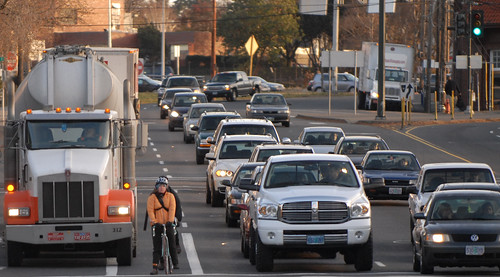
(Photos © J. Maus/BikePortland)
The long, cold war between Portland’s bike/pedestrian advocates and its freight advocates might finally be thawing, people involved in recent talks say.
The latest evidence: Trucking advocates have signed on to soften a set of state rules that might have essentially blocked all new bike lanes, road diets and crosswalk upgrades on state-owned commercial streets such as Lombard Street through St. Johns, Powell Boulevard through Southeast Portland and the Tualatin Valley Highway through downtown Beaverton and Hillsboro.
After two years of discussion, freight and bike/pedestrian experts have settled on a revised state rule that explicitly allows road changes as long as they don’t physically block the passage of wide freight loads.

build relationships with freight advocates
like Corky Collier (R).
Corky Collier, a freight advocate working in Portland since 2004, said communication between bike and truck experts has clearly been improving.
“On a range of 10, maybe it was a 4 in the past, but now it’s more like a 7 or an 8,” Collier said Wednesday. He credited the improvement to solid personal relationships among a few key players.
That’s one reason Bicycle Transportation Alliance Advocacy Director Gerik Kransky has been attending the city’s freight committee meetings, 7:30 a.m. on the first Thursday of each month, since 2010. The fruits of those labors were on display back in December when Kransky worked — with Collier’s support — to restore funding cuts for active transportation when the two served together on the City of Portland’s Budget Advisory Committee.
“Having a few friends goes a long way,” Kransky said.
The state law currently being interpreted is known as the “hole in the air” rule, because it seeks to ensure that wide freight loads — mobile home components, wind turbine blades, large machinery — will always be able to use state highways “unless safety or access considerations require the reduction.”

freight loads under a proposed implementation of state law.
From a biking perspective, there are serious problems with the law, passed with little fanfare by Oregon’s legislature in 2003. For example, it’s far from obvious that wide-load freight should be a top transportation priority on a street that runs right through central Hillsboro — Tualatin Valley Highway, which just this month was named by the BTA as a top prospect for a “world-class bikeway.”
Other roads affected include Route 99 East through central Milwaukie and Route 99 West through central Tigard, as well as U.S. 30 northwest of Portland and all the region’s freeways.
Still, the law is the law, bike advocates involved in the process say — and freight advocates have agreed to significant compromises in its interpretation, including potential reduction of auto travel lanes, restriping to create bike lanes, and narrowly defining the affected streets.
For example, the MLK-Grand couplet through central Portland was one potential corridor that would have been prioritized for wide-load freight traffic. But Metro transportation engineer Anthony Buczek said he’d successfully argued for a clarification that because that couplet is controlled by the City of Portland rather than the state, it would be exempt from the rule. Buczek was also among several who pushed for the addition of a bike lane to not be considered a reduction of freight capacity.
As for the TV Highway, Kransky said he ensured that the proposed rules explicitly state that reducing the number of auto travel lanes — in order to add a buffered bike lane, for example — does not constitute a reduction in freight capacity, either. An off-road path along the highway would also remain feasible, Kransky added.
“They see the opportunity … to have a lot of pedestrian and bike advocates understand the needs of freight movement. Hopefully that’s a two-way street.”
— Anthony Buczek, Metro transportation engineer
“The policy, I think, is a big improvement from where it was,” Buczek said Tuesday. “My sense is that all sides really were committed.”
The Oregon Transportation Commission is accepting comments on the proposed rules until July 15. Among the significant issues is whether low pedestrian bump-outs can be installed without interfering with freight passage. And as talk continues about ways to improve North Lombard Street, it’s not yet clear how these state rules might tie the hands of city planners.
Buczek, the Metro engineer, said freight experts are also eager to persuade active transportation experts that trucking is both important and complicated.
“They see freight marginalized in a lot of ways, whether you agree with that or not,” Buczek said. “So they see the opportunity to have more modes at the table, to have a lot of pedestrian and bike advocates understand the needs of freight movement. Hopefully that’s a two-way street: that we get freight advocates understanding better the needs of pedestrians and bicyclists.”

